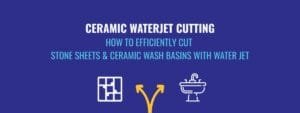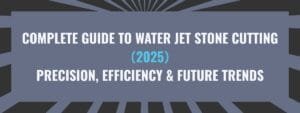(一) Overview of Waterjet Cutting Technology
Waterjet cutting stands as a revolutionary non-contact, non-thermal manufacturing process. By harnessing high-pressure water streams (reaching up to 690 MPa) mixed with abrasives like garnet, it generates a supersonic jet traveling at 900 m/s—capable of slicing through diverse materials with surgical precision. Its key advantages include:
- Thermal Integrity Preservation: Eliminates material distortion, hardening, or structural degradation typically caused by heat-intensive processes.
- Universal Material Compatibility: Excels in cutting metals, glass, stone, ceramics, wood, plastics, and even high-strength alloys like titanium.
- Precision Engineering: Achieves an impressive accuracy of 0.1 mm, enabling complex 2D/3D designs without the need for specialized tooling.
- Sustainable Operation: Emits zero hazardous fumes and allows for the recycling of wastewater and abrasives.
(二) Core Application Fields
1. Metal Cutting
- Ideal Materials: Titanium, aluminum, stainless steel, copper, etc., supporting thicknesses up to : Titanium, aluminum, stainless steel, copper, etc., supporting thicknesses up to :钛、铝、不锈钢、铜等,支持的厚度可达300 mm..
- Competitive Edge: Outperforms laser and plasma cutting with lower equipment costs, zero thermal distortion, and ready-to-use cut edges.
- Cutting Method Comparison
| Cutting Method | Process Principle | Material Restrictions | Thickness Capacity | Precision |
| Waterjet | High-pressure abrasive jet | Virtually all materials | Up to 300 mm | 0.1 mm |
| Laser | Focused laser beam ablation | Metals, thin aluminum | ≤20 mm | 0.1 mm |
| Plasma | Ionized gas arc melting | Ferrous/non-ferrous metals | 25–30 mm | 0.3–0.5 mm |
| EDM | Electrical discharge erosion | Conductive materials only | ≤250 mm | 0.01 mm |
Comparative Analysis of Laser And Water Jet Cutting
| Comparison Criteria | Laser Cutting | Water Jet Cutting |
| Cutting Approach | Laser ablation | Abrasive water jet |
| Cutting Speed | 1,778 mm/min (70 in/min) | 508 mm/min (20 in/min) |
| Heat Affected Zone | Present | None |
| Cutting Precision | 0.15 mm | 0.5 mm |
| Max. Material Thickness | 30–40 mm | 250–300 mm |
| Noise Level | 75 dB | 90 dB |
| Material Compatibility | Metals, plastics, composites, glass | Metals, ceramics, glass (excl. tempered glass & diamonds) |
2. Stone Cutting
- Industry Applications: Ideal for intricate wall/logo carvings, floor inlays, and countertop fabrication (marble, granite, tiles). Enables “zero-clearance” cutting of complex geometries.
- Process Benefits: Produces smooth, chip-free edges, making it a preferred choice for high-end interior design projects.
3. Glass Cutting
- Technical Highlights:
A. Initiates with a reduced 80 MPa pressure for drilling, ramping up to operational speeds (e.g., 1,000–1,500 mm/min at 350 MPa for 6 mm glass).
B. Utilizes proportional pressure control to prevent fracturing, suitable for artistic, automotive, and mirrored glass applications.
4. Wood Cutting
- Equipment Features: Equipped with high-precision blades, variable speed controls, CNC interfaces, and automated feeding systems. Supports multi-angle cutting and integrated dust extraction for furniture and custom woodworking.
5. Other Industrial Applications
- Aerospace: Precision-cutting critical components like engine parts, turbine blades, and landing gear assemblies.
- Automotive: Mass-producing components such as bumpers, seals, and copper shims with automated workflows.
- Electronics & Medical: Fabricating delicate items like circuit boards, waterproof enclosures, medical implants, and orthopedic devices.
- Architecture & Art: Creating stone reliefs, metal sculptures, and bespoke interior decor elements.
(三) Key Technical Parameters and Material Cutting Data
| Material | Thickness (mm) | Cutting Speed (mm/min) | Pressure (MPa) |
| Steel/Stainless Steel | 2 | 800–1,200 | 350 |
| 20 | 50–90 | 350 | |
| 100 | 2–6 | 350 | |
| Aluminum | 6 | 500–1,000 | 350 |
| Titanium | 2 | 800–1,200 | 350 |
| Glass | 6 | 1,000–1,500 | 350 |
| Marble | 10 | 700–1,200 | 350 |
| Ceramic | 10 | 1,200–1,500 | 350 |
(四) Technical Types and Cutting-Edge Developments
1. Type Classification
- Abrasive Waterjet Cutting: Incorporates garnet abrasives, optimized for machining hard materials like metals, stone, and ceramics.
- Pure Waterjet Cutting: Relies solely on high-pressure water, ideal for soft materials such as rubber, foam, food products, and textiles.
2. Technological Advancements
- 5-Axis Waterjet Systems: Enable direct 3D model machining, minimizing human intervention and streamlining complex part production.
- Taper Compensation Technology: Corrects thickness-related taper errors through CAD adjustments or dynamic cutting head movements, achieving ±0.005 inches precision.
3. Advantages and Limitations
- Strengths:
A. Maintains material integrity without thermal damage.
B. Handles extreme thicknesses up to 300 mm.
C. Adapts seamlessly across material types with minimal setup changes.
D. Adheres to strict environmental standards with zero emissions.
- Challenges:
A. Demands significant upfront investment (30,000–500,000).
B. Operates at slower speeds compared to laser cutting, especially for metals.
C. Incurs ongoing abrasive costs and potential nozzle wear.
D. Requires additional compensation for taper in thick materials.
(五) Frequently Asked Questions
Q: What are viable alternatives to waterjet cutting?
A: Laser cutting, plasma cutting, electrical discharge machining (EDM), and wire cutting.
Q: Which metals work best with waterjet cutting?
A: Aluminum alloys (e.g., 6061), copper alloys, and stainless steel grades (304/316).
Q: How is abrasive material integrated into the process?
A: Abrasives like garnet are metered into the water stream via an automated hopper, utilizing the Venturi effect to create a high-velocity cutting mixture.
(六) Conclusion
Waterjet cutting has firmly established itself as a cornerstone technology in modern manufacturing, valued for its non-thermal precision and material agnosticism—especially critical for heat-sensitive or thick substrates. Despite capital cost and speed constraints, its eco-friendly nature and versatility render it indispensable across aerospace, automotive, and construction sectors. With continuous advancements in multi-axis control and intelligent machining, waterjet technology is poised to redefine precision cutting capabilities in future industrial applications.
X-mind for this article, download HD image in videos & PDFs, watch cutting videos on youtube




